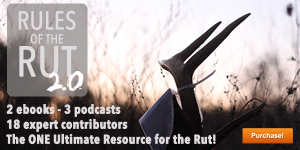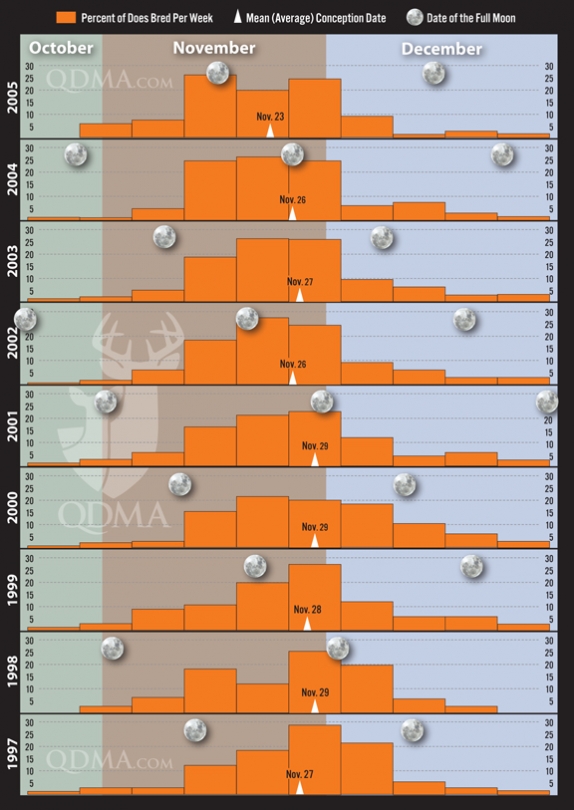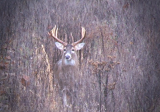
By Mark Kenyon
Here we are! Another year, another set of rut predictions, and another opportunity to debate the warrant of predicting the rut at all! Yes, predicting the timing of the rut is a bit of a controversial topic, but it’s a debate that we all love having. And that’s because we just can’t get enough of it.
It’s that time of year that we whitetail addicts look forward to all year and for good reason. The rut is the best time of year to see big old bucks on their feet and you just never know what might happen. Hell, I’m getting pumped for this coming November just thinking about this.
That said, today we’re going to review the two most popular schools of thought regarding rut predictions. First, we’ll share Charles Alsheimer and Wayne Laroche’s popular moon based rut predictions for the new year, and then we’ll dive into the other side of the debate and the traditional photo-period theory for the timing of the rut.
Finally, I also thought I’d take a look back at the past five years of rut predictions and compare them with the actual activity I personally saw and offer a few personal opinions on these predictions and theories.
So grab a calendar, get ready to book those vacation dates, and get pumped. Because we’re talking about the rut!
NOTE: If you’re interested in learning more about actually hunting during the rut, be sure to check out our “Rules of the Rut 2.0″ eBooks and Podcasts, featuring top whitetail experts from Field & Stream, Outdoor Life, North American Whitetail, Deer & Deer Hunting Magazine, and more! Click the image below to learn more.
Wayne Laroche/Charles Alsheimer Lunar 2015 Rut Predictions
As many of you know, each year Deer & Deer Hunting’s Charles Alsheimer releases a series of rut predictions based on a lunar calendar. Today, we’ll be sharing the first phase of these rut predictions – those being the basics of what Alsheimer’s Lunar Calendar predicts for the 2015 rut.
But first – lets recap the basis for these predictions. Alsheimer and wildlife biologist Wayne Laroche have been studying the timing of the rut for nearly 20 years now and these predictions are based on their findings. According to Deer & Deer Hunting’s 2015 Whitetail Calendar and Rut Predictions, “The rut predictor is based on a model that links cyclical changes in the Earth’s solar and lunar illumination to the whitetail’s reproductive cycle. Wayne and Alsheimer hypothesize that sunlight and moonlight provide environmental cues that set, trigger and synchronize breeding.”
Ultimately, according to this theory the second full moon after the autumn equinox is believed to trigger the peak in rutting activity, and Wayne and Alsheimer’s predictions revolve around this “Rutting Moon”.
So that said – when does the “Rutting Moon” hit this year and what will that mean for rutting activity in 2015?
***
This year the “Rutting Moon” is earlier than last year by about a week, falling on October 27th. That’s compared to a Rutting Moon of November 6th in 2014 and the especially late Rutting Moon in 2013 of November 17th. That late moon in 2013, according to Laroche/Alsheimer, resulted in a “trickle rut” with most rutting activity happening later than usual (third or fourth weeks in November), with other peaks and valleys occurring sporadically over late October and mid November. Meanwhile, the 2014 Rutting Moon fell in the sweet spot of early November, which supposedly syncs up well with other rutting factors – and results in a synchronized and frenzied rut.
That said, what does this even earlier October 27th “Rutting Moon” mean for the rut in 2015? Well, according to this theory, this would mean that the majority of rutting behavior should be earlier than last year, but still relatively in line with the “typical” whitetail rut we’re used to seeing. Rutting activity looks to be somewhat similar to which we saw in 2012, when the Rutting Moon fell on October 29th and during the 2012 rut I saw strong rutting activity during that late October/early November time period.
According to Alsheimer’s Lunar Calendar, major “seeking” behavior should pick up around October 20th and continue until around October 27th, when major “chasing” should begin. This peak in visible rutting activity will continue until around November 3rd when the “tending” phase should be kicking into gear and continue through the 10th.
So what does this mean for hunters? If you believe these predictions, it would mean that the typical “prime time” of the first week or two of November should be, as usual, a great time to be in the woods! But you might be seeing even more action than usual during that last week of October as well. According to this prediction, October 25th – November 3rd should be some of the best hunting of the entire season, when the most seeking and chasing will be happening, which is in fact the “rutting behavior” that hunters are most interested in seeing. Major rutting activity, to a slightly lesser degree, should continue on through the 10th.
The Traditional View on Rut Prediction Theories
On the other side of the aisle, when it comes to rut timing theories, many other biologists and whitetail experts believe that the timing of the actual rut (peak breeding) is NOT variable nor impacted by lunar factors (excluding some Southern US regions – where rut timing is very scattered). In fact, according to many studies, the actual peak of breeding appears to be consistent year after year.
According to a recent publication from The Quality Deer Management Association, “The bottom line is northern whitetails have a narrow breeding window to optimize doe and fawn health and survival. This is why numerous studies across the northern United States and Canada looking at conception dates show very little year-to-year variation. In fact, these breeding dates are amazingly consistent from year to year – regardless of moon phase, weather patterns, or other variables.”
Expanding on this point, QDMA Director of Communications Lindsay Thomas Jr explains “The science on this is decisive. A significant number of scientific, peer-reviewed studies have shown the timing of the rut in any particular location is triggered by photoperiod, or day length – not by the moon, or temperature, or anything else…I think hunters often confuse visible rut behaviors, like chasing and grunting, with the peak of breeding. When you document breeding dates in a location, they actually change very little year to year, even though the dates of peak rut behaviors might vary. That’s because weather, moon phase and food sources – things that fluctuate widely year to year – affect deer movement patterns. But even when the weather reduces deer movement, you find that breeding still takes place the same time it normally does. If a doe is coming into estrous, a warm front isn’t going to change that.”
In another article produced by the Quality Deer Management Association, it was explained that, “Scientists have known for decades that the length of daylight each day, which fluctuates throughout the seasons, serves as the trigger for hormone changes in deer that bring on breeding and the rut – though the timing of the trigger varies widely in different regions and deer populations for several other reasons. But stories persist among hunters that the moon plays a role.”
That said, Rod Cumberland, a deer management biologist for the Canadian province of New Brunswick, conducted a study examining a data set of more than 1,600 does providing fetal data across nine years to determine conception dates. The chart below, produced by the QDMA, shows the results of that analysis, and the fact that peak breeding is very consistent. According to the researchers, “our analysis revealed that the relationship between annual breeding dates and moon phase chronology was highly variable. Therefore, we believe it is not necessary to revise the conventional understanding among deer biologists that breeding dates are primarily influenced by photoperiod (day length) and are relatively consistent among years within a particular population.”
For more on this fascinating study, click the image below for a full size view or visit the original article on QDMA.com by clicking this link –> No Link Between Moon Phase and Rut Peak
Bill Winke of MidwestWhitetail.com seems to concur with all of this, as he is quoted saying” “I have not seen a rut predictor that was actually more accurate than the calendar. The rut is triggered by photoperiod – the amount of sunlight (number of hours) in each day. As the season progresses, that triggers the rut at pretty much the same time every year. You may see more behavior on certain days than others related to weather or hunting pressure, but the actual conception dates of the does are pretty consistent from year to year. Missouri recently did a study back-dating fetuses from late season harvested does and they proved that over a three year period the peak breeding date (the date when the most does were in estrous) was November 15 plus or minus one day. I always like to hunt during the week that starts ten days before the peak. In this case November 5 – 12. It is tough to beat that time frame. ”
Rut Timing In The South
Timing the rut South of the Mason-Dixon line seems to be a whole other can of worms and much more variable. According to Alsheimer, “Southern whitetails don’t face the harsh winters and brutal conditions that dictate when Northern whitetail fawns must be born to ensure they are large enough to survive severe winters. Harsh cold and deep snows aren’t part of the Southern equation, so weather isn’t a factor for fawn births. Therefore, the South’s rut appears to be driven by less obvious factors, such as climate, genetics, nutrition, day length, moon phases and doe-to-buck ratios…It’s crucial to check with a local biologist to find out what month the rut typically occurs at a specific location.”
My Own Opinion On The Rut Prediction Theories
So, with all of these various opinions on the matter out of the way, lets discuss my own personal views on the timing of the rut.
First, regarding Laroche’s/Alsheiemer’s predictions, over the past five years my own personal observations have loosely matched up – to some degree – with these predictions. In 2010 and 2013, when a “trickle rut” was predicted, I saw noticeably less daylight rutting activity (seeking/chasing) and the activity I did see seemed to be much more sporadic and spread out. In 2011, 2012 and 2014, when a more typical rut was predicted, I saw a more concentrated and intense amount of rutting activity during the first few weeks of November.
That said, in all five years, I still did see the majority of rutting activity happening in late October and the first two weeks of November. Given these observations, I generally fall more into the camp that stands with the scientific studies indicating a consistent timing of the breeding cycle – regardless of moon.
As the studies have repeatedly shown, fetus tests indicate that the majority of breeding (in the North) almost always occurs around mid-November, regardless of moon or other factors. This would mean that, typically, most seeking and chasing will be occurring during the week or two preceding that date. My current hypothesis is that this November 15th peak breeding date holds true, and that the two preceding weeks will almost always be the “peak” of rutting behavior (seeking/chasing). But, I do believe that other factors such as the moon cycle or weather may impact the visible intensity of that activity – especially during the day. I look at these other factors as intensifiers or dampeners of daylight activity, but not major factors in the actual timing of breeding
That said, while I’m always curious to see what the lunar predictions are, and I’m happiest when they seem to line up for a good rut, I’ll still be focusing my heaviest hunting efforts on the first two weeks of November, no matter what the lunar theory predictions indicate.
What Are Your Thoughts?
Now we want to know what you think!
What are your thoughts? Are you a believer in Laroche and Alsheimers theory or not? What determines your rut hunting vacation dates – the lunar theory or the dates on the calendar?
If you’re interested, check out the links below to the rut prediction articles from the past five years and see how they compare to your actual observations. Then let us know in the comments what your thoughts are…
If you’re interested in learning more about Laroche and Alsheimer’s Lunar Rut Theory – pick up a copy of Deer & Deer Hunting’s 2015 Whitetail Calendar which includes the full rut predictions.
Finally, if you’d like more rut hunting advice and strategies, download our “Rules of the Rut 2.0″ eBook and Podcast package, which includes two 100% rut focused eBooks and three downloadable podcasts featuring contributors from Field & Stream, Outdoor Life, North American Whitetail, Deer & Deer Hunting and more! More information can be found at the link below…
If you’re interested in more on this topic, check out our recent podcast episode in which we debate the 2015 rut predictions and theories! –> Wired To Hunt Podcast – Episode #61: 2015 Rut Predictions & Theories





